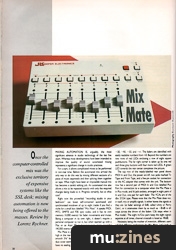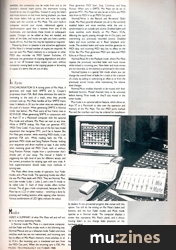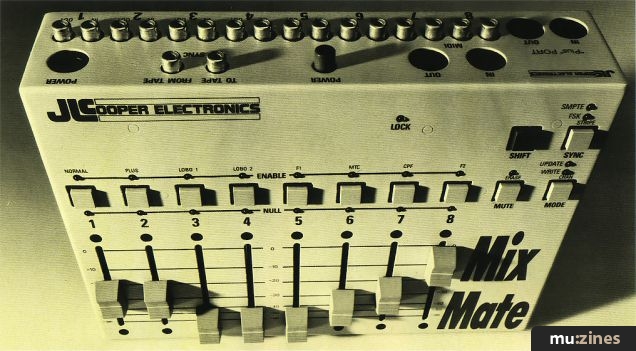Magazine Archive
Home -> Magazines -> Issues -> Articles in this issue -> View
JL Cooper Mix Mate | |
Article from Music Technology, October 1988 | |
Once the exclusive territory of costly systems like the SSL desk, automated mixing is quickly becoming widely available. Lorenz Rychner looks at an automation system aimed at the budget studio.
Once the computer-controlled mix was the exclusive territory of expensive systems like the SSL desk; mixing automation is now being offered to the masses.

MIXING AUTOMATION IS, arguably, the most significant advance in studio technology of the last five years. Whereas most developments have been intended to improve the quality of sound, automated mixing represents a significant change in studio practices.
For a start, it allows complicated mixes to be performed in non-real time. Before the automated mix arrived the only way to do this was by mixing different sections of a piece of music separately and then splicing them together on tape. What might have been an impossible manual mix has become a careful editing job. An automated mix also allows a mix to be repeated exactly with only the required changes being made to it. Progress certainly, but at what cost?
Right now the proverbial "recording studio in your bedroom" can boast self-contained automated and synchronised mixdown of up to eight tracks if you find a niche for a small box labelled "Mix Mate". It speaks MIDI, MTC, SMPTE and FSK sync codes, and it has its own memory (4,000 events) for fader movements and mutes. Being a computer in its own right, it doesn't require a personal computer to run it, but when teamed up with a Mac or an Atari ST, it becomes even more powerful (40,000 events more powerful, amongst other features).
Mix Mate is just 10" wide, 7" deep, and a little over 2" high at the rear of its slightly slanted case. Eight firm but smooth 3 5/8" faders take up the near half of its panel. A dust cover seems a must, since the 1/8"-wide fader cutouts have no sealing. Calibration markings show 0, -10, -20, -30, -40, -50, and -x. The faders are identified with easily readable numbers from 1-8. Beyond the numbers are two rows of red LEDs enclosing a row of eight square pushbuttons. The far right comer is taken up by one red and three grey buttons with four more red LEDs. A green LED towards the rear center completes the picture.
The top row of the neatly-labelled rear panel shows MIDI In and Out, the power on/off, two jacks marked To Tape and From Tape, and a five-pin socket for connection to the AC adapter that comes with the unit. The bottom row has a second pair of MIDI In and Out labelled Plus Port for connection to a computer when the Mix Mate is in Plus mode, and 16 jack sockets, arranged in eight pairs of In and Out, one pair for each fader. The VCAs are of the dbx 2155A type. Please note that the Mix Mate does not, in itself, mix or amplify signals. It either leaves the signals as they are (at fader settings of OdB, called Unity or Parity Gain), or it attenuates them by as much as -81dB in 64 steps across the throw of the faders (126 steps when in Plus mode). The eight In/Out pairs keep the eight signals separate at all times, channel crosstalk is listed as -90dB.
Necessity being the mother of invention, different users will find different applications for Mix Mate. Let's look at the most obvious situation, the mixdown of a multitrack recording to stereo two-track. Instead of feeding the individual track audio outs from the multitrack tape recorder to a mixing desk, each track is first connected to one of the Mix Mate's eight inputs, and each of the Mix Mate's outputs is fed to a channel on the mixer. Where available, this connection may be made from and to the console's channel insert points, the alternative routing would be by way of a patdibay. Instead of using the faders and mute buttons on the mixer during playback, you leave the mixer faders fully up and mix and mute the audio tracks with the controls on Mix Mate. The unit's built-in computer records your moves, referenced against a synchronisation signal that it receives from one of the multitracks, and reproduces these moves on subsequent passes. Changes can be added as they are needed, and when all the fades and mutes are right you have a perfect hands-off mix. And that mix may be repeated as required.
Mastering direct to cassette is one attractive application of Mix Mate if a limited number of copies are required. As you can save Mix Mate's memory to a computer or other midi data recorder via MIDI System Exclusive, it'll eliminate one generation of copying degradation and allow you to run off however many copies you want without constantly running back to the copying people or drowning in copies of a demo that are out of date.
In Sync
SYNCHRONISATION IS A strong point of Mix Mate. It generates and reads both SMPTE and JL Cooper's proprietary Smart FSK. Both these eliminate the need for rewinding to the start of a track, since they provide constant lock-up. Mix Mate handles all four SMPTE frame rates. It defaults to 30, but the other rates are selectable at the push of a button. When generating SMPTE in Normal mode (see below), Mix Mate starts all four frame rates at 00.59.45.00. When generating SMPTE in conjunction with an Atari ST or a Macintosh computer with the optional Plus mode and software, Mix Mate can start at any time. While in SMPTE lockup, Mix Mate can generate MTC (MIDI Time Code). If you have one of the few late-model sequencers that recognise MTC, you'll be in heaven. But Mix Mate gets smarter: while receiving MIDI clocks, it can generate FSK sync. While reading back the FSK, it generates MIDI clocks and Song Position Pointer, locking your sequencer and drum machine to tape. It also works when receiving good old MIDI Clock, with or without Song Position Pointer, maybe from a synchroniser that's already part of your setup. The manual is helpful in suggesting the right kind of sync for different setups, and the correct procedure for striping tape with sync code. A little experimentation should make most methods of syncing easy.
Mix Mate offers three modes of operation, four Fader modes, and a Mute mode. The operating modes also affect the way Mix Mate deals with MIDI. They are Normal, Plus, and Lobo modes (Lobo 1, Lobo 2, and a new F1 mode to be called Lobo 3). Each of these modes offers further choices. This all gets a little complicated, because the Mix Mate has no LCD or other readout - switching is done by pressing and holding buttons while tapping other buttons. Various combinations of LED lights indicate the status.

Modes
HERE'S A SUMMARY of what Mix Mate will and will not do in its various operating modes.
In Normal mode Mix Mate is a stand-alone computer, and the Fader and Mute modes work in the following way. Normal/Manual acts as a rehearsal mode. Faders and mute switches work but are not memorised, and incoming sync has no effect on Mix Mate's memory, mute switches, or on its VCAs. But incoming sync is translated and sent from the MIDI Out port. When the incoming sync is FSK, Mix Mate generates MIDI Start, Stop, Continue, and Song Pointer. When sync is SMPTE, Mix Mate can be set to generate MTC. Mix Mate can also be set to Echo any MIDI data from its MIDI In to its MIDI Out ports.
Normal/Write is the Record and Re-record (Edit) mode. Mix Mate Records whatever you do to the currently enabled faders and mute switches while the unit is synchronised to an outside sync source. Enabled faders and mute switches work directly on Mix Mate's VCAs, affecting the signals passing through the In-Out pairs, and overwriting any previously recorded actions. Disabled faders and mute switches are in Read (playback only) mode. The enabled faders and mute switches generate no MIDI data, and incoming MIDI data has no effect on the VCAs. But Mix Mate generates MIDI sync data and MIDI Echo as in Manual mode.
Normal/Read All is the Playback mode, where Mix Mate repeats the previously recorded fader and mute moves while locked to incoming sync. New fader and mute moves are not recorded, as the memory is protected in this mode.
Normal/Update is a special Edit mode where you can change the overall level of fades for a track or for a section of a track, by adding or subtracting an offset to or from the previously stored moves, while maintaining the relative level changes.
Normal/Mute enables channels to be muted with their dedicated buttons. Muted channels have to be unmuted before leaving Mute mode, or they'll stay muted in the other modes.
Plus mode is an optional add-on feature, which allows an Atari ST or a Macintosh to take over the operation and memory of the Mix Mate. The two MIDI ports marked Plus and the interface card may be ordered for installation by dealers. A non-protected program disk comes with this option. You still do the mixing on Mix Mate's faders and buttons, and the four Fader modes and Mute mode operate as in Normal mode. The computer displays a screen that represents Mix Mate's panel, and it shows moving faders as you change fader positions on the hardware panel.
The computer now provides you with other niceties. You can type a name under each fader and you can label the screen with your song title, project name or whatever.
It also helps overcome the absence of motorised faders; the computer screen shows both the real faders and moving phantom faders. This becomes even more important when you need to make adjustments and want to avoid sudden jumps in level from the last recorded level to the current position of the fader. In Update mode the phantom faders give you that reference. You an also choose screen colours, have the computer save to disk automatically whenever Mix Mate stops hearing incoming sync (you can also save whenever you want), and select SMPTE format and start time for recording SMPTE on tape. The computer can display bars and beats (after you input the time signature) or SMPTE hours:minutes:seconds:frames while locked to sync. And it displays the remaining memory in percentages.
The other modes are called Lobo 1-3. Ponder the impenetrable trade secrets: is this an abbreviation of lobotomy because it's a brainless mode, or should it be Loco as in Local Off? Anyone familiar with Local Off in MIDI should have no trouble with these modes. While Mix Mate is in Lobo mode, the faders are disconnected from the internal VCAs and they respond only to incoming MIDI data. You can still hear the effect of your moves instantly, but your sequencer has to receive and echo back the data.
In Lobo 1 mode each fader transmits and receives a specified MIDI controller number on Mix Mate's current MIDI Channel, with the travel of the fader covering the available range of each controller. In Lobo 2 mode each fader transmits and receives a specified MIDI Note number on Mix Mate's current MIDI channel, with the fader position representing velocity. In the new F1 mode (soon to be called Lobo 3 mode), the faders send and receive MIDI controller 7 volume, on separate MIDI channels that must be adjacent (1-8, or 7-14, or 13-16 and wrapping around to 1-4, and so on). The signals from multitimbral instruments with separate outputs (Yamaha TX802, Roland D110) and rack units like the TX816 can be controlled in this way. Sure you could do this in the regular way, by addressing their little brains with controller 7, but anyone who has cursed the noisy output of TF1 modules in the TX816 will appreciate the difference this makes.
Verdict
I'M HAPPY TO report that Mix Mate successfully combines automation, computer interfacing, and synchronisation functions. There's one major problem which is not Mix Mate's fault. Consider the signal flow during mixing: tape tracks to Mix Mate In, through Mix Mate's VCAs, Mix Mate Out to mixer channel inputs, through the EQ and Sends and Returns to the stereo master outputs and into your two-track recorder. Since all signal attenuation is done in Mix Mate, the mixer channel faders need to remain fully up. This will neatly expose any noisy circuitry in the mixing desk. During quiet passages, you may be in big trouble. My experiments with different desks showed just how small or large a problem this could be - listen arefully to your mixer before committing yourself to Mix Mate.
The manual is excellent. Users of the Plus mode can go straight to their own chapter where all the necessary text is repeated, in context, from the earlier Normal mode chapter. If you hate jumping around a manual as much as I do, you'll appreciate this. The small booklet is ringbound and lies flat or even folded over. The sections are neatly structured, with subheadings exposed in the left margin. It's almost a good bedtime read.
Prices Mixmate (basic unit), £995; with Plus Mode upgrade, £1190. All prices include VAT
(Contact Details)
Also featuring gear in this article
Publisher: Music Technology - Music Maker Publications (UK), Future Publishing.
The current copyright owner/s of this content may differ from the originally published copyright notice.
More details on copyright ownership...
Review by Lorenz Rychner
Help Support The Things You Love
mu:zines is the result of thousands of hours of effort, and will require many thousands more going forward to reach our goals of getting all this content online.
If you value this resource, you can support this project - it really helps!
Donations for April 2024
Issues donated this month: 0
New issues that have been donated or scanned for us this month.
Funds donated this month: £7.00
All donations and support are gratefully appreciated - thank you.
Magazines Needed - Can You Help?
Do you have any of these magazine issues?
If so, and you can donate, lend or scan them to help complete our archive, please get in touch via the Contribute page - thanks!








